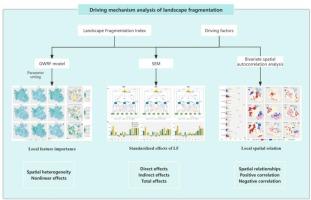城市景观破碎化的驱动因素:局部贡献、空间关系和因果效应
IF 7
2区 环境科学与生态学
Q1 ENVIRONMENTAL SCIENCES
引用次数: 0
摘要
快速城市化极大地改变了景观格局,导致景观破碎化,对生物多样性、生态系统功能和人类福祉造成影响。了解景观破碎化的驱动因素对于制定可持续的城市规划战略至关重要。本研究调查了中国南昌这座快速城市景观破碎化的空间模式和驱动机制。我们使用地理加权随机森林(GWRF)模型、空间自相关分析和结构方程模型(SEM)分析了 2000 年、2010 年和 2022 年的景观破碎化模式,并评估了九种自然和人为因素的影响。我们的研究结果表明,景观破碎化具有明显的空间异质性,高破碎化热点集中在东南部和中部地区。土地覆被变化强度和人类活动强度是影响破碎化的主要人为因素,表现出很强的空间相关性和因果效应。土地覆被变化强度和人类活动强度分别占地方特征重要性最高等级的 44.58% 和 34.78%。人类足迹与破碎化在统计上也呈现出显著的正空间相关性(平均莫兰 I = 0.5304)。此外,土地覆被变化强度对景观破碎化有直接的正向影响,平均标准化路径系数为 0.41。坡度和人类足迹也发挥了重要作用,主要是通过间接影响(平均值分别高于 0.3 和 0.35)。随着时间的推移,不透水表面扩张强度的影响在空间相关性和因果效应方面呈现出倒 "U "形,这表明虽然最初的城市扩张会加剧破碎化,但后期的城市化和绿地恢复可以减轻这些影响。本文章由计算机程序翻译,如有差异,请以英文原文为准。

Driving factors of fragmentation in urban landscapes: Local contributions, spatial relationships, and causal effects
Rapid urbanization significantly alters landscape patterns, leading to fragmentation with implications for biodiversity, ecosystem function, and human well-being. Understanding the drivers of fragmentation is crucial for developing sustainable urban planning strategies. This study investigates the spatial patterns and driving mechanisms of landscape fragmentation in Nanchang, China, a rapidly urbanizing city. We analyze landscape fragmentation patterns for 2000, 2010, and 2022 and assess the influence of nine natural and anthropogenic factors using a geographically weighted random forest (GWRF) model, spatial autocorrelation analysis, and structural equation modeling (SEM). Our results reveal significant spatial heterogeneity in landscape fragmentation, with high-fragmentation hotspots concentrated in the southeastern and central regions. The intensity of land cover change and human activity emerge as the dominant human factors influencing fragmentation, exhibiting strong spatial correlations and causal effects. land cover change intensity and human activity intensity account for 44.58 % and 34.78 % of the highest ranking local feature importance, respectively. The human footprint also demonstrates a statistically significant positive spatial correlation with fragmentation (mean Moran’s I = 0.5304). Furthermore, land cover change intensity exerts a direct positive influence on landscape fragmentation, as indicated by an average standardized path coefficient of 0.41. Slope and human footprint also play important roles, primarily through indirect effects (mean value above 0.3 and 0.35, respectively). The influence of impervious surface expansion intensity showed an inverted “U” shape over time in spatial correlation and causal effect, suggesting that while initial urban expansion increases fragmentation, advanced urbanization and green space restoration can mitigate these effects.
求助全文
通过发布文献求助,成功后即可免费获取论文全文。
去求助
来源期刊

Ecological Indicators
环境科学-环境科学
CiteScore
11.80
自引率
8.70%
发文量
1163
审稿时长
78 days
期刊介绍:
The ultimate aim of Ecological Indicators is to integrate the monitoring and assessment of ecological and environmental indicators with management practices. The journal provides a forum for the discussion of the applied scientific development and review of traditional indicator approaches as well as for theoretical, modelling and quantitative applications such as index development. Research into the following areas will be published.
• All aspects of ecological and environmental indicators and indices.
• New indicators, and new approaches and methods for indicator development, testing and use.
• Development and modelling of indices, e.g. application of indicator suites across multiple scales and resources.
• Analysis and research of resource, system- and scale-specific indicators.
• Methods for integration of social and other valuation metrics for the production of scientifically rigorous and politically-relevant assessments using indicator-based monitoring and assessment programs.
• How research indicators can be transformed into direct application for management purposes.
• Broader assessment objectives and methods, e.g. biodiversity, biological integrity, and sustainability, through the use of indicators.
• Resource-specific indicators such as landscape, agroecosystems, forests, wetlands, etc.
 求助内容:
求助内容: 应助结果提醒方式:
应助结果提醒方式:


